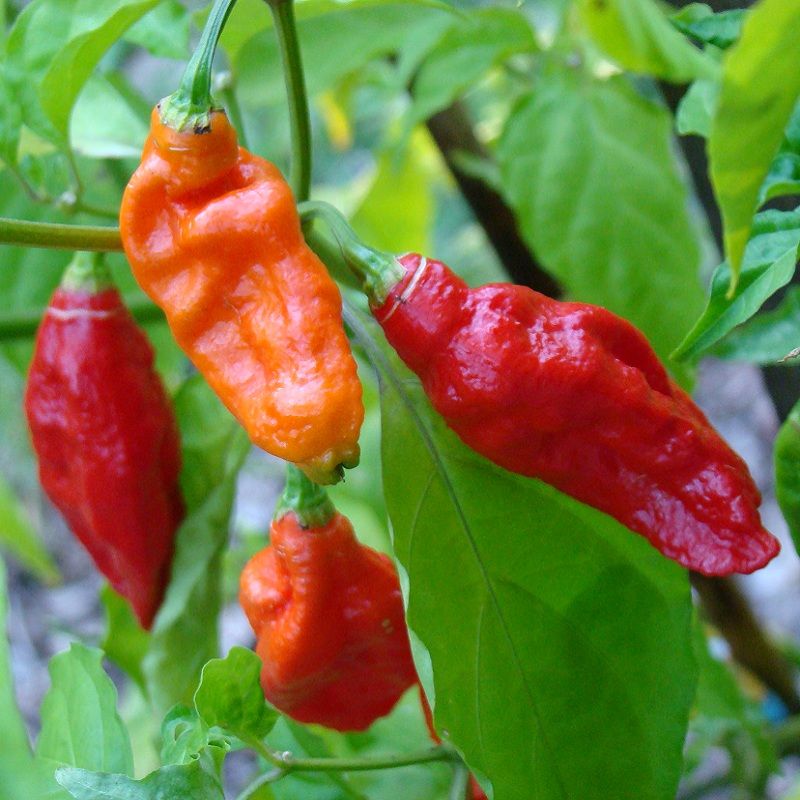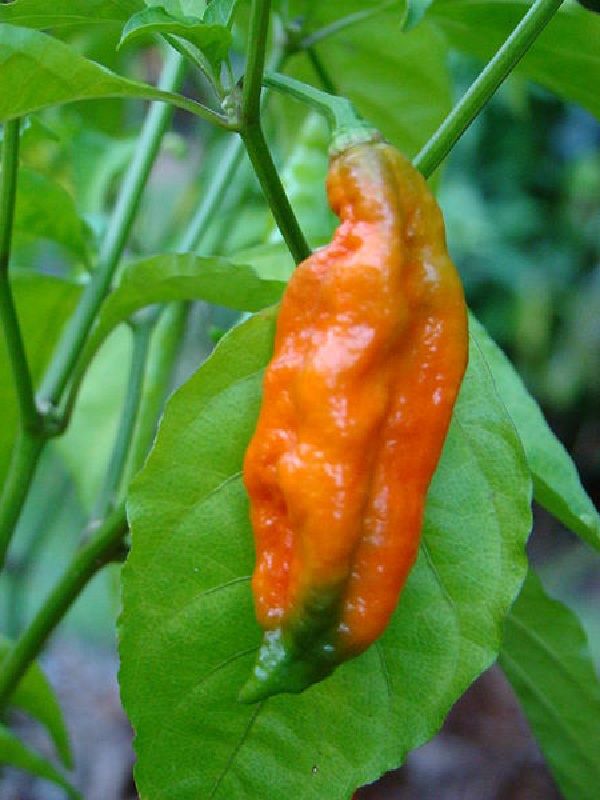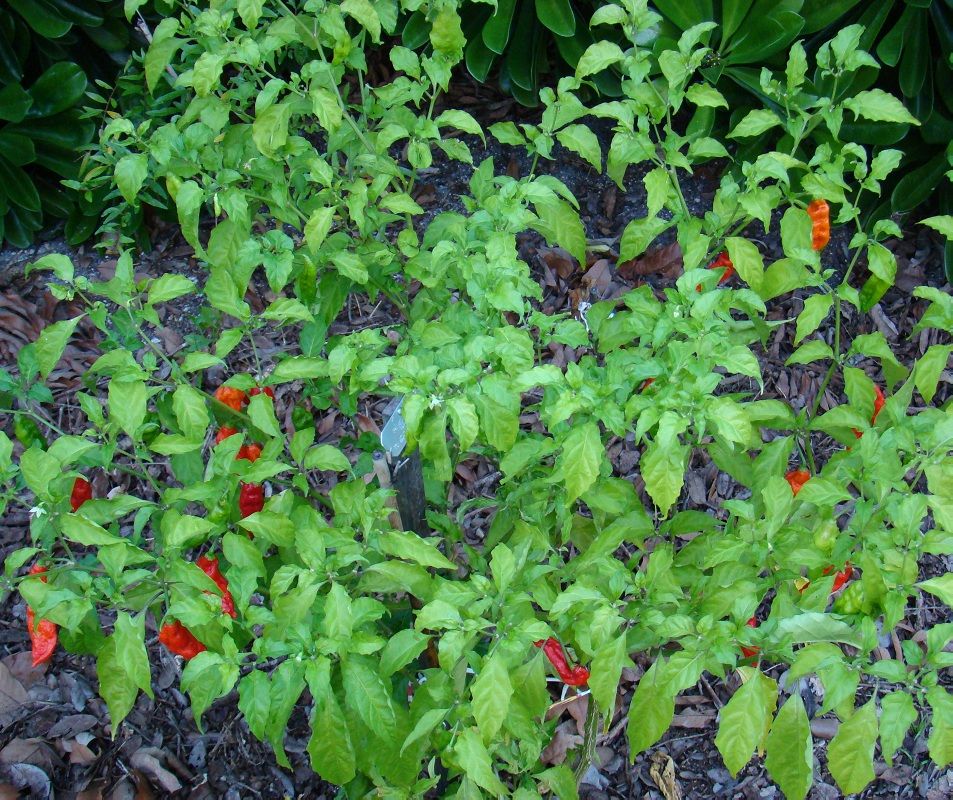
Characteristics
Ripe peppers measure 60 to 85 mm (2.4 to 3.3 in) long and 25 to 30 mm (1.0
to 1.2 in) wide with an orange or red color. The unselected strain of Bhut
Jolokia from India is an extremely variable plant, with a wide range in
fruit sizes and amount of fruit production per plant, and offers a huge
potential for developing much better strains through selection in the
future.
|
Scoville rating
Bhut Jolokia chili pepper Heat Maximum (SHU: 1,041,427)
In 2000, India's Defence Research Laboratory (DRL) reported a rating of
855,000 heat units (SHU) on the Scoville scale, and in 2004 a rating of
1,041,427 units was made using HPLC analysis. For comparison, Tabasco
red pepper sauce rates at 2,500–5,000, and pure capsaicin (the chemical
responsible for the pungency of pepper plants) rates at
15,000,000–16,000,000 SHU.
In 2005, at New Mexico State University Chili Pepper Institute near Las
Cruces, New Mexico, regents Professor Paul Bosland found Bhut Jolokia grown
from seed in southern New Mexico to have a Scoville rating of 1,001,304 SHU
by HPLC.
The effect of climate on the Scoville rating of Bhut Jolokia peppers is
dramatic. A 2005 study comparing percentage availability of capsaicin and
dihydrocapsaicin in Bhut Jolokia peppers grown in Tezpur (Assam) and Gwalior
(Madhya Pradesh), India showed that the heat of the pepper is decreased by
over 50% in Gwalior's more arid climate.
Elsewhere in India, scientists
at Manipur University measured Bhut Jolokia's average Scoville rating by
HPLC at only 329,100 SHU. |
In 2007, Guinness World Records certified the Bhut Jolokia as the world's
hottest chili pepper, 401.5 times hotter than Tabasco sauce. On December
3, 2010, the Bhut Jolokia was replaced as the hottest known chili pepper by
the Naga Viper pepper, which has an average peak Scoville rating more than
300,000 points higher than an average Bhut Jolokia - but still not higher
than the hottest ever recorded Dorset Naga. In February 2011, Guinness
World Records awarded the title of "World's Hottest Chilli" to the Infinity
chili grown in Grantham, England. This chilli rates at 1,067,286 units
on the Scoville scale. Later the same month, on February 25, 2011, the
title returned to the Naga Viper pepper with a rating of 1,382,118 Scoville
Heat Units (SHU). Currently these figures are highly controversial among
the pepper growing community and tests with more rigorous scientific
standards are yet to be conducted on the many various peppers vying for
"world's hottest" status.
Etymology
The pepper is called different names in different regions. An article in the
Asian Age newspaper stated that experts in Assam are worried about a
distortion of the colloquial nomenclature of "Bhot" to "bhut", saying that
this word was misinterpreted by the (Western) media to mean "ghost".
The
article stated that people living north of the Brahmaputra River call the
pepper "Bhot jolokia", "Bhot" meaning "of Bhotiya origin", or something that
has come from the hills of adjoining Bhutan; on the southern bank of the
river Brahmaputra, this chili becomes Naga jolokia, believed to have
originated from the hills of Nagaland. An alternative source for Naga
jolokia is that the name originates from the ferocious Naga warriors who
once inhabited Nagaland.
Further complicating matters, a 2009 paper,
published in the Asian Agri-History journal, coined the English term "Naga
king chili" and stated that the most common Indian (Assamese) usage is bhoot
jolokia, which refers to the chili's large pod size, and gives the
alternate common name as bih jolokia (bih means "poison" in Assamese,
denoting the plant's heat).
The assertion that bhut (bhoot) means "ghost" is
claimed by researchers from the New Mexico State University, but as in the
article from the Asian Age, denied by Indian researchers from Nagaland
University. The Assamese word "jolokia" simply means the Capsicum
pepper. Other usages on the subcontinent are saga jolokia, Indian mystery
chili, and Indian rough chili (after the chili's rough skin). It has
also been called the Tezpur chili after the Assamese city of Tezpur. In
Manipur, the chili is called umorok, or oo-morok (oo = "tree", morok =
"chili").
|
The pepper is used in India in homeopathic preparations for stomach
ailments. It is also used as a spice as well as a remedy to
summer heat, presumably by inducing perspiration in the consumer. In
northeastern India, the peppers are smeared on fences or incorporated in
smoke bombs as a safety precaution to keep wild elephants at a distance.
In 2009 as a weapon, scientists at India's Defence Research and Development
Organization announced plans to use the peppers in hand grenades, as a non
lethal way to flush out terrorists from their hideouts and to control
rioters. It will also be developed into pepper spray as a self defense
product.
R. B. Srivastava, the director of the Life Sciences Department at the New
Delhi headquarters of India's Defense Research and Development Organization
(who also led a defense research laboratory in Assam), said trials are also
on to produce bhut jolokia-based aerosol sprays to be used by potential
victims against attackers and for the police to control and disperse mobs.
Dorset Naga
Dorset Naga (Capsicum chinensis) is a subspecies of the original Naga,
selected from the Bangladeshi varieties of the chili, naga morich.
Annually, since 2005, the heat level of Dorset Naga has been tested, taking
samples from different sites, various seasons and states of maturity. The
heat level has ranged from 661,451 SHU for green fruit in 2007, up to
1,032,310 SHU for ripe fruit harvested in 2009.
High as the results were, the BBC's Gardeners' World television program
recorded a much higher heat level for Dorset Naga. As part of the 2006
programming, the BBC gardening team ran a trial looking at several chili
varieties, including Dorset Naga. Heat levels were tested by Warwick HRI and
the Dorset Naga came in at 1,598,227 SHU, the hottest heat level ever
recorded for a chili. |











 All live plants are shipped bare-root wrapped in moist
sphagnum moss to ensure the plant’s healthy transit to you.
All live plants are shipped bare-root wrapped in moist
sphagnum moss to ensure the plant’s healthy transit to you. 



